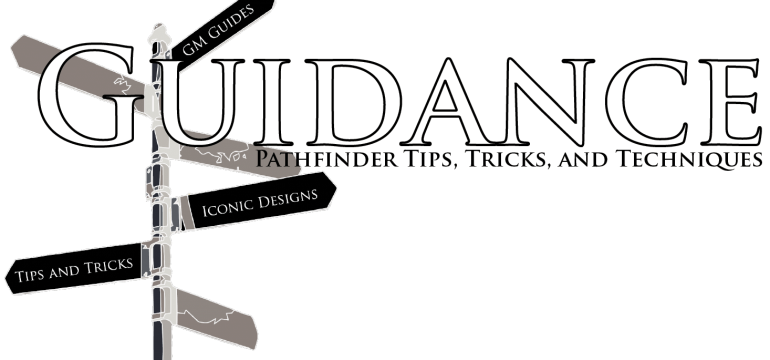Part 3 of our ongoing look at being a freelancer is here! First, I talked about how to be a marketable freelancer for the Pathfinder RPG. Last week, I discussed why being lawful in regards to the two major laws involving the Pathfinder RPG is crucial to being marketable. This week, we’re going to be looking at being lawful in a completely difference sense—being lawful to the rules themselves, a concept I call standardization.
As a publisher, getting my freelancers to the point where they are standardized is the hardest thing about working with freelancers. As special and cool as any given freelancer thinks her ideas are, ideas are cheap. While idea generation as a skill can be valuable (we’ll talk about that in two weeks when we get to the final marketability item, innovative), if you get a room filled with 100 chipanzees with no training into a room with a bunch of type writers, probability states that eventually at least one good idea will be created in there somewhere. The truth of the matter is that everyone has good ideas, and what’s worse, I can be inspired by other people’s good ideas for free. Whether we’re talking about drawing on the works of famous literary works, taking inspiration from something another company did, or even just browsing an internet threat where people are chatting, ideas are EVERYWHERE, and no one’s ideas, not even a professional’s ideas, are priceless.
The value of an idea is in its application, and that is the essence of standardization.
Types of Standardization
When we talk about standardization in Pathfinder, we’re talking two avenues in particular—standardization of text, and standardization of mechanics. Another way to discuss this idea is to call standardization Pathfinder’s “Voice,” it’s the way in which words and ideas are presented to the reader. Both types of standardization are similar, but also very different. If you master these skills as a freelancer, your publisher will notice, especially if they’re very text-oriented, and it will likely get you more work. Each type of standardization is very different, however, so I’d like to take the time to go over them both separately.
Mechanical Standardization
In the Pathfinder Roleplaying Game, no ability is ever worded the way it is by accident. For example, we never say “a large zombie” in our rules text unless we mean “a Large zombie,” meaning specifically that some terms have very specific meanings within the context of the game’s mechanics, and those concepts are more important then figurative language. For example, the word “missile” means “projectile” and the spell snowball is a magic effect, but to call snowball a “magic missile” is wrong. We would need to use one of the appropriate terms, such as “a ranged spell” or a “1st-level spell” or a “ranged touch attack.” All are appropriate in terms of the game’s mechanics.
But mechanical standardization goes beyond “flavor text,” it also applies to the way mechanics themselves are written. For instance, everything from spells to feats to classes are written and presented in a very specific order in Pathfinder. They are consistency, and writers are expected to find and follow that consistency too. The best way to learn this consistency is to play the game, and note how things are worded. More importantly then how, note why. For instance, have you ever noticed that all fighter archetypes are written with male third-person pronouns, while all swashbuckler archetypes are written with female third-person pronouns, while all feats are written in second-person? This is a conscious choice on Paizo’s part (class content always uses the gender of the class’s iconic character), and a good publisher will want to make their products feel more “official” by copying Paizo’s choices, which in turn means that they expect their freelancers to do the same.
A good resource for learning mechanical standardization is Rogue Genius Games’ style guide. It includes TONS of little nuances that you probably never noticed, but are consistently employed throughout the game. If you are serious about being a freelancer, especially one who works for Paizo, read RGG’s list. Know it and love it.
Textual Standardization
Just as Pathfinder has a common voice in its rules, its next has a common voice as well. This type of standardization is much harder to pick up and relies a lot more on not only your best judgment, but your developer’s best judgment too. As a general rule, Pathfinder tends to avoid second-person in its writing—feats, spells, and certain rules systems are really the only exceptions. Additionally, Pathfinder tends to avoid dwelling on one subject for too long, and they avoid telling the GM more than the minimum that is needed about a given subject. This is hard for more flowery writers, but in a game like Pathfinder, it’s often form over function unless you’re writing things that you intend the GM to read. Think of it this way—if you were planning on using a monster in your game as a GM, do you want Paizo telling you exactly how to use it and why, or do you want to be able to fit it into your game as it works best for you?
In addition, Pathfinder’s default gender is female. Meaning that if you don’t have a good reason to use male pronouns (such as “I’m writing an archetype for a fighter), you should use female pronouns. Another good rule to keep in mind is that Paizo always uses one space after their periods, not two. Apparently that’s a thing that’s hard for some people—I don’t know, one space is always how I learned it in school myself. Finally, make sure you’re using English spellings (anything non-English is itanlicized) and always make sure your voice “sounds” like Paizo’s. This is a skill that you will only pick up if you practice—I recommend picking up Paizo’s books and reading them often, out loud if possible. That’s the only way to get good at this type of standardization.
Final Thoughts on Standardization
Now, before you go nuts and start making read aloud groups, I will admit that as far as publishing goes, textual standardization is icing on the cake compared to mechanical standardization. Unless you’re planning on being a fiction author, it is WAY more important to write rules the way that Paizo does.
As you might have guessed, standardization is an art you must master, rather than a skill that I can teach you. When you get good at standardization, your publishers will know, and you will get work because your work is standardized. One of the common comments that I personally get from Paizo developers who look at my work is that, “They can always tell when I work on something because it always accounts for the little details that would have otherwise broken the option.” Does the feat work weirdly with an archetype from Ultimate Combat? I note it. Does the archetype provide a broken combo with a spell from Ultimate Magic? I note it and close the exploit. Having a strong working repertoire of the game’s rules and how they’re written will help you keep your work solid and memorable in the eyes of everyone who reads it.
But ultimately, the best way for you to learn how to do this is to read and reference CONSTANTLY. If you want to write something, check to see if Paizo has published anything (and I mean ANYTHING) with similar wording and use that wording to start your work. For instance, whenever I want to say, “This option uses your level as your effective class level,” my go-to reference is the sanctified slayer archetype for inquisitors, especially the studied target ability. I ALWAYS use how that archetype references the slayer class as my baseline for how my rules should reference other classes for determining effective levels. Using and researching Paizo’s rules as an example for standardizing your writing is the best, most efficient way to make sure that your work is standardized.
Next week, we’re going to hit the last two of the four important marketability traits for Pathfinder Freelancers—Timely. And don’t you worry, this one won’t be late!
So until next time, I’m Alex Augunas and I’m always here for YOU when you need a little bit of Guidance. Take care!
Alexander “Alex” Augunas has been playing roleplaying games since 2007, which isn’t nearly as long as 90% of his colleagues. Alexander is an active freelancer for the Pathfinder Roleplaying Game and is best known as the author of the Pact Magic Unbound series by Radiance House. Alex is the owner of Everyman Gaming, LLC and is often stylized as the Everyman Gamer in honor of Guidance’s original home. Alex also cohosts the Private Sanctuary Podcast, along with fellow blogger Anthony Li, and you can follow their exploits on Facebook in the 3.5 Private Sanctuary Group, or on Alex’s Twitter, @AlJAug.






